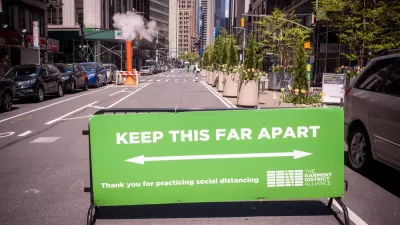A leading youth engagement in planning program, explained.
Juell Stewart shares news of efforts to attract more youth, especially females and people of color, to the field of planning.
"Youth engagement programs also address the structural barriers that prevent young people from engaging in formal outreach processes by translating the language of planning and the complexities of civic participation in a way that empowers them to take active leadership roles within their communities," explains Stewart. "The bottom line: The earlier youth are introduced to planning principles, the sooner they can begin building both their future careers and communities."
The Chicago Metropolitan Agency for Planning's Future Leaders in Planning (FLIP) program, serves exactly that purpose, under the leadership of Katanya Raby, who features heavily in the article.
FLIP works with high school students of diverse backgrounds from across CMAP's seven-county Chicagoland region, creating a way for kids to learn about what makes the world (and city) around them tick — and the language they can use to describe it. The curriculum uses urban planning as a vehicle to get students to contemplate the deeper social issues that undergird policy decisions and urban development. For Raby, it boils down to one guiding question: "How can we get students to have these conversations earlier and think strategically about how we can build our next generation of leaders?"
The article digs into more detail on the FLIP program, as exemplified by the summer 2019 cohort, and offers more advice on how to get young people of color interested in the field of planning. For instance, the article also five tips for attracting youth to planning, with more details provided in the source article:
- Trust and listen to younger residents
- Ditch the jargon
- Get out of the classroom!
- Work with universities
- Partner with school districts.
FULL STORY: Planning for Future Leaders

Alabama: Trump Terminates Settlements for Black Communities Harmed By Raw Sewage
Trump deemed the landmark civil rights agreement “illegal DEI and environmental justice policy.”

Planetizen Federal Action Tracker
A weekly monitor of how Trump’s orders and actions are impacting planners and planning in America.

The 120 Year Old Tiny Home Villages That Sheltered San Francisco’s Earthquake Refugees
More than a century ago, San Francisco mobilized to house thousands of residents displaced by the 1906 earthquake. Could their strategy offer a model for the present?

In Both Crashes and Crime, Public Transportation is Far Safer than Driving
Contrary to popular assumptions, public transportation has far lower crash and crime rates than automobile travel. For safer communities, improve and encourage transit travel.

Report: Zoning Reforms Should Complement Nashville’s Ambitious Transit Plan
Without reform, restrictive zoning codes will limit the impact of the city’s planned transit expansion and could exclude some of the residents who depend on transit the most.

Judge Orders Release of Frozen IRA, IIJA Funding
The decision is a victory for environmental groups who charged that freezing funds for critical infrastructure and disaster response programs caused “real and irreparable harm” to communities.
Urban Design for Planners 1: Software Tools
This six-course series explores essential urban design concepts using open source software and equips planners with the tools they need to participate fully in the urban design process.
Planning for Universal Design
Learn the tools for implementing Universal Design in planning regulations.
Clanton & Associates, Inc.
Jessamine County Fiscal Court
Institute for Housing and Urban Development Studies (IHS)
City of Grandview
Harvard GSD Executive Education
Toledo-Lucas County Plan Commissions
Salt Lake City
NYU Wagner Graduate School of Public Service





























